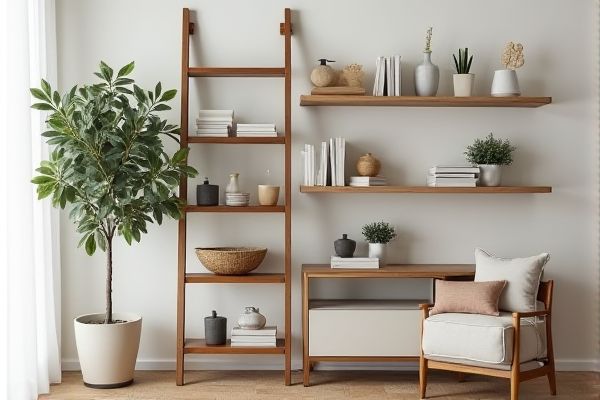
Ladder shelves offer a more structured, tiered design ideal for maximizing vertical storage while leaning shelves provide a sleek, angled aesthetic that saves floor space. Discover which option best suits your space and style needs by reading the rest of the article.
Table of Comparison
| Feature | Ladder Shelf | Leaning Shelf |
|---|---|---|
| Design | Vertical with multiple tiered shelves resembling a ladder. | Slanted shelves supported by a frame leaning against a wall. |
| Installation | Freestanding, no wall mounting required. | Requires wall support for stability. |
| Space Efficiency | Compact, uses vertical space efficiently. | Optimizes corner and wall space with angled design. |
| Use Case | Ideal for books, decor, plants in living rooms or offices. | Perfect for accent storage, display in bedrooms or entryways. |
| Material Options | Wood, metal, or a combination. | Typically wood or metal with wood accents. |
| Weight Capacity | Moderate, suitable for lightweight to medium items. | Varies; leaning angle affects load stability. |
| Portability | Easy to move and reposition. | Less portable due to wall dependence. |
Introduction to Ladder Shelves and Leaning Shelves
Ladder shelves feature a tiered design with shelves that progressively decrease in depth from bottom to top, offering sturdy storage ideal for books, plants, and decor. Leaning shelves, similar in structure, rest against a wall at an angle, combining space-saving functionality with aesthetic appeal for displaying art or everyday items. Your choice depends on balancing stability needs and the visual openness each style provides in your living space.
Design Differences Between Ladder and Leaning Shelves
Ladder shelves feature evenly spaced shelves supported by a sturdy frame resembling a step ladder, providing functional storage with a clean, geometric look. Leaning shelves typically have a more relaxed, angled design that rests against the wall, offering a casual aesthetic with variable shelf depths that increase from top to bottom. Understanding these design differences helps you select the right shelf style to complement your space and storage needs.
Space-Saving Capabilities
Ladder shelves maximize space-saving by offering multiple tiers of storage that lean against the wall without requiring floor footprint extension, ideal for tight corners or narrow rooms. Leaning shelves provide a similar space-efficient design, but their angled structure often allows for easier installation and versatility in placement. Both designs optimize vertical space usage while minimizing horizontal clutter, making them excellent solutions for small apartments or offices.
Material and Build Quality Comparison
Ladder shelves are typically made from sturdy hardwood or metal, providing a durable and robust build ideal for holding heavy items, while leaning shelves often feature lighter materials like pine or MDF, making them easier to move but less suited for substantial weight. Both designs offer various finishes, but ladder shelves usually emphasize stability with reinforced joints and thicker planks, ensuring long-lasting strength. When choosing between the two, your preference for material impact and build quality should align with the intended weight capacity and durability needs.
Stability and Safety Features
Ladder shelves typically offer enhanced stability due to their wider base and angled design, reducing the risk of tipping over, which makes them safer for homes with children or pets. Leaning shelves rely on wall support and must be securely anchored to prevent accidents, making proper installation crucial for safety. When choosing, consider Your space and whether you can securely mount the leaning shelf to ensure optimal stability and safety.
Installation and Setup Process
Ladder shelves typically require more effort during installation, often involving screws or brackets to secure the structure to the wall, ensuring stability and safety. Leaning shelves are designed for effortless setup, simply leaning against a wall without the need for extensive tools or hardware, making them ideal for renters or quick room refreshes. Your choice between the two should consider how much time and effort you want to invest in the installation process while maintaining the desired aesthetic and functionality.
Aesthetic Appeal and Style Options
Ladder shelves offer a sleek, modern aesthetic with clean, vertical lines that complement minimalist and contemporary interiors. Leaning shelves showcase a more relaxed and casual style, often featuring angled supports and open designs that enhance rustic or bohemian decor. Both provide versatile style options, but ladder shelves prioritize structured elegance while leaning shelves emphasize informal charm.
Practical Uses and Functionality
Ladder shelves offer versatile storage with multiple tiers ideal for organizing books, plants, and decor while maximizing vertical space in compact areas. Leaning shelves lean against walls, providing easy assembly and flexible placement but typically hold lighter items due to stability constraints. Both designs enhance room aesthetics, but ladder shelves support heavier loads making them more practical for functional storage needs.
Price Range and Budget Considerations
Ladder shelves typically range from $50 to $200, making them an affordable option for budget-conscious buyers seeking versatile storage. Leaning shelves often start around $100 and can exceed $300, reflecting their more robust construction and design variations. Budget considerations should include material quality and intended use, as these factors influence both cost and longevity.
Choosing the Best Shelf for Your Needs
Ladder shelves offer multiple tiers with sturdy, evenly spaced platforms ideal for organizing books and decorative items, while leaning shelves provide a sleek, angled design that saves floor space and adds a modern aesthetic. Consider your room size, storage requirements, and style preferences when deciding between the two, as ladder shelves suit traditional setups and leaning shelves complement minimalist interiors. Your choice should balance functionality and design to enhance your living space effectively.
 homyna.com
homyna.com